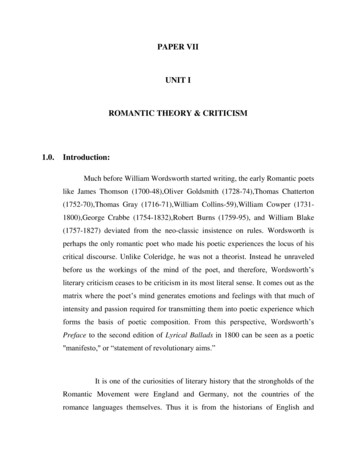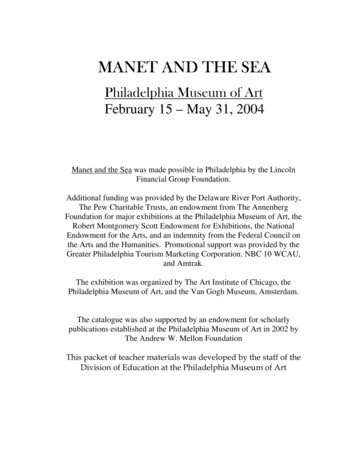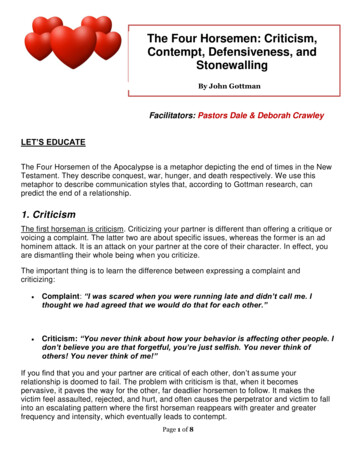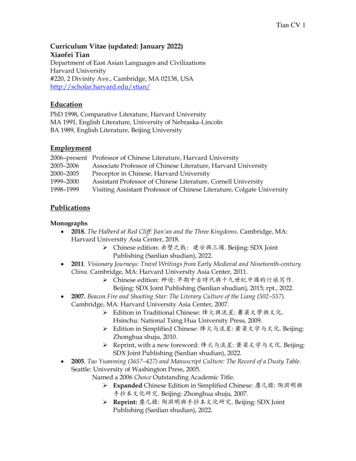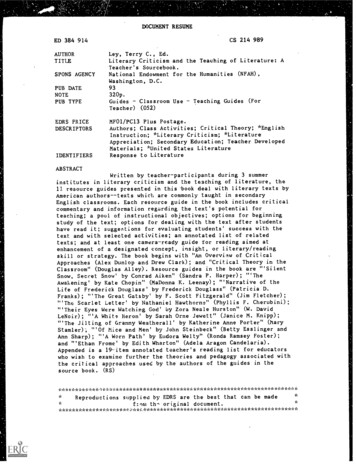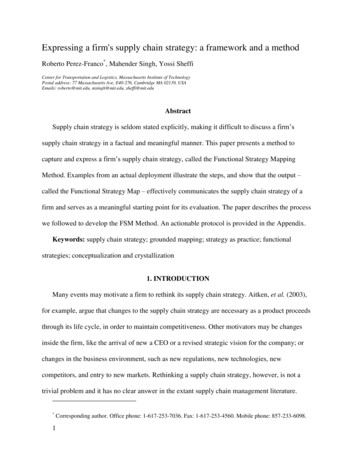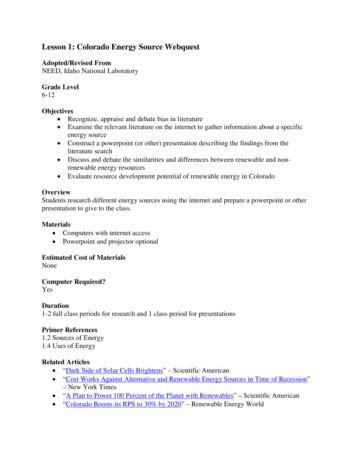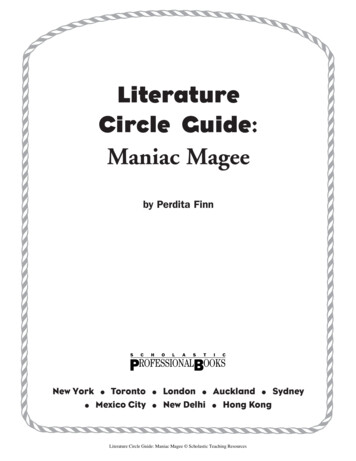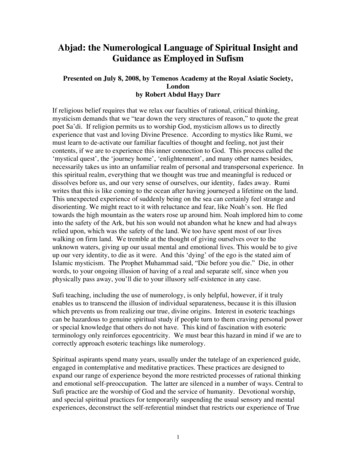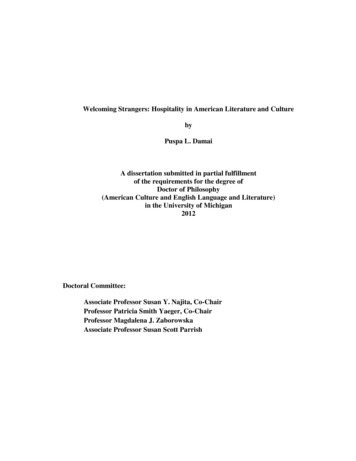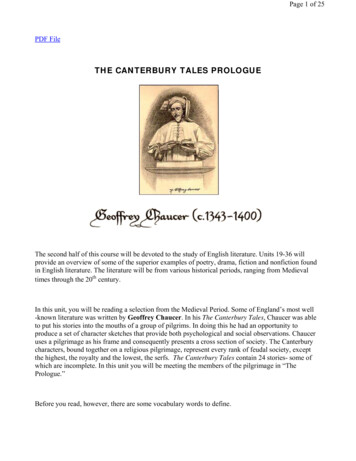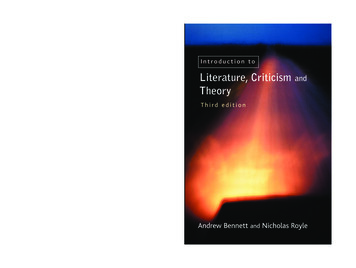
Transcription
AW234x156.qxd 5/6/08 11:16 AM Page 1.The most un-boring, unnerving, unpretentious textbook I've ever come across.Elizabeth Wright, University of CambridgeI don’t know of any book that could, or does, compete with this one. It isirreplaceable.Richard Rand, University of Alabama[Bennett and Royle have] cracked the problem of how to be introductory andsophisticated, accessible but not patronising.Peter Buse, English Subject Centre NewsletterIntroduction to Literature, Criticism and Theory provides a completely fresh andoriginal introduction to literary studies.creative writingliterature and filmwarmonsters, mutants and the inhumanIntroduction to Literature, Criticism and Theory avoids what is so frequentlytiresome or intimidating about ‘theory’, offering instead an introduction that isconsistently entertaining, thought provoking and surprising.andThird editionThirdeditionBennettand RoyleThe authors have wide experience of teaching and lecturing on literature andliterary theory at universities in Britain, Europe and the United States. AndrewBennett is Professor of English at the University of Bristol and Nicholas Royle isProfessor of English at the University of Sussex.Literature, CriticismTheoryTheory Introduction toandBennett and Royle approach their subject by way of literary works themselves (apoem by Emily Dickinson, a passage from Shakespeare, a novel by SalmanRushdie), rather than by way of abstract theoretical ideas and isms. In 32 shortchapters they focus on a range of familiar-looking terms (character, the author,voice, narrative) as well as less obvious ones (laughter, pleasure, ghosts, secrets)in order to show why such literary texts are so compelling. This third editionupdates and expands on earlier editions, and includes new chapters on:Literature, CriticismIt is by far the best and most readable of all such introductions that I knowof.The treatment of the various topics is masterful, even-handed andinformative. I cannot think of a better introduction for undergraduates, to besure, but for many graduate students too.Hayden White, University of California at Santa CruzIntroduction toThe best introduction to literary study on the market.Jonathan Culler, Cornell UniversityAndrew Bennett and Nicholas RoyleCover Getty imageswww.pearson-books.com
AIT A01.qxd 14/05/2004 14:47 Page i.‘An exceptional book. It is completely different from anything else currently available, refreshing, extremely well-written and original in somany ways . . . It is just the sort of book I would want my students toread . . . It is quite the best introductory book that I have ever comeacross.’ Philip Martin, De Montfort University‘Fresh, surprising, never boring, and engagingly humorous, whileremaining intellectually serious and challenging . . . This is a terrificbook, and I’m very glad that it exists.’ Peggy Kamuf, University ofSouthern California, Los Angeles‘This excellent book is very well-written and an outstanding introduction to literary studies. An extremely stimulating introduction.’ RobertEaglestone, Royal Holloway, University of London‘I am convinced that Bennett and Royle have written a pathbreakingwork and I suspect that this book – so full of laughter, suspense, secretsand pleasure – will have an appeal beyond a strictly academic audience.’Alan Shima, University of Gothenberg‘All the chapters in the volume are illuminating, informative and original.’ Robert Mills, King’s College London‘Bennett and Royle offer a different kind of introduction, which directlyinvolves the reader in the problems and pleasures of thinking aboutliterature – its distinctiveness, its strangeness, its power, its inexhaustibility . . . They succeed brilliantly in encouraging readers who arenew to theory to appreciate its importance, enjoy its revelations, andunderstand some of its conceptual apparatus without diminishing thecentrality of literary writing itself. This is a book which students inevery introductory course on criticism and theory would benefit fromhaving.’ Derek Attridge, University of York
AIT A01.qxd 14/05/2004 14:47 Page ii.
AIT A01.qxd 14/05/2004 14:47 Page iii.An Introduction to Literature, Criticism and Theory
AIT A01.qxd 14/05/2004 14:47 Page iv.
AIT A01.qxd 14/05/2004 14:47 Page v.An Introduction toLiterature, Criticismand TheoryThird editionANDREW BENNETT ANDNICHOLAS ROYLE
AIT A01.qxd 14/05/2004 14:47 Page vi.PEARSON EDUCATION LIMITEDEdinburgh GateHarlow CM20 2JEUnited KingdomTel: 44 (0)1279 623623Fax: 44 (0)1279 431059Website: www.pearsoned.co.ukThird edition published in Great Britain in 2004 International Book Distributors Limited 1995 Pearson Education Limited 1995, 1999, 2004The rights of Andrew Bennett (1960– ) and Nicholas Royle (1957– )to be identified as authors of this work have been asserted bythem in accordance with the Copyright, Designs and Patents Act 1988.ISBN 0 582 82295 5British Library Cataloguing-in-Publication DataA CIP catalogue record for this book can be obtained from the British LibraryLibrary of Congress Cataloging-in-Publication DataA CIP catalog record for this book can be obtained from the Library of CongressAll rights reserved; no part of this publication may be reproduced, storedin a retrieval system, or transmitted in any form or by any means, electronic,mechanical, photocopying, recording, or otherwise without either the priorwritten permission of the Publishers or a licence permitting restricted copyingin the United Kingdom issued by the Copyright Licensing Agency Ltd,90 Tottenham Court Road, London W1T 4LP. This book may not be lent,resold, hired out or otherwise disposed of by way of trade in any formof binding or cover other than that in which it is published, without theprior consent of the Publishers.10 9 8 7 6 5 4 3 2 108 07 06 05 04Set by 35 in 11/13pt Bulmer MTPrinted in MalaysiaThe Publisher’s policy is to use paper manufactured from sustainable forests.
AIT A01.qxd 14/05/2004 14:47 Page vii.ContentsAcknowledgementsPreface to the first editionPreface to the second editionPreface to the third edition123456789101112131415161718192021The beginningReaders and readingThe authorThe text and the worldThe uncannyMonumentsNarrativeCharacterVoiceFigures and tropesCreative writingLaughterThe tragicHistoryMeGhostsMoving picturesSexual 8778593103113124133142152161171178
AIT A01.qxd 14/05/2004 14:47 Page seRacial differenceThe colonyMutantThe performativeSecretsThe postmodernPleasureWarThe end187197206214223233240248258268280GlossarySelect bibliography of other introductory texts and reference worksLiterary works discussedBibliography of critical and theoretical worksIndex288297299304328
AIT A01.qxd 14/05/2004 14:47 Page ix.Acknowledgementse are grateful to Michael Ayres for permission to reproduce his poemW‘Bittersweet’ published in Poems, 1987–1992 by Odyssey Poets.In some instances we have been unable to trace the owners of copyrightmaterial and we would appreciate any information that would enable us todo so.
AIT A01.qxd 14/05/2004 14:47 Page x.Preface to the first editionhis is a new kind of book. It offers new ways of thinking about literatureTand about what is involved in reading critically. It is designed to be clearand accessible to those who are beginning to study literature, as well as to moreadvanced students. Although written with university students in mind, wedare to hope that it might also be of interest to other readers.Literary theory is an unavoidable part of studying literature and criticism.But theory – especially when it takes the form of ‘isms’ – can often be intimidating or else, frankly, boring. We have tried to avoid simply giving pottedsummaries of isms. Instead we present brief essays on a range of key criticalconcepts all of which have more or less familiar names. We put these conceptsinto practice through readings of particular literary texts. Our primary focus,in other words, is on what is powerful, complex and strange about literaryworks themselves. Our aim is to explain, entertain, stimulate and challenge.The book is divided into twenty-four chapters and looks as if it has a certainorder or progression. It begins with ‘The beginning’ and ends with ‘The end’.But it has been put together in such a way that it can also be read startingfrom any one chapter. ‘The end’, for example, is not a bad place to begin.Each chapter concludes with some suggestions for further reading. There isa glossary of critical and theoretical terms at the back of the book, plus a fullbibliography of the texts discussed.
AIT A01.qxd 14/05/2004 14:47 Page xi.Preface to the secondeditionhis new edition of An Introduction to Literature, Criticism and TheoryThas been thoroughly revised and, we hope, improved. We have revisedall existing chapters, updated and expanded the further reading sections,the glossary and the bibliography, and also added four new chapters:‘Monuments’, ‘Ghosts’, ‘Queer’ and ‘The colony’. These additional chaptersreflect the importance of certain new or emerging areas of literary studies,such as queer theory, postcolonial theory, debates about ‘the canon’ and spectrality. We also hope, however, that the new chapters may complement andreinforce what we believe was already distinctive about the first edition ofthis book, namely its preoccupation with literature and the literary as such.Our foremost desire has been to explore and analyze the strange, proteanforms and effects of the literary and of literature as an institution. Thissecond edition, then, attempts to make explicit in new ways our continuing fascination with literary works themselves – with, for example, theirmonumental, ghostly, queer and colonizing power.
AIT A01.qxd 14/05/2004 14:47 Page xii.Preface to the third editionor this third edition we have, once again, revised and updated the book asFthoroughly as possible. Some of the revisions are so small that, we suspect,only Bennett and Royle will ever notice; others are more substantial. We havealso added four new chapters: ‘Creative writing’, ‘Moving pictures’, ‘Mutant’and ‘War’. In each case, we have sought to acknowledge and engage withrecent developments in literature, criticism and theory in what we hope arerefreshing, informative and stimulating ways.
AIT C01.qxd 13/05/2004 14:46 Page 1.1.The beginninghen will we have begun?Where – or when – does a literary text begin? This question raises aWseries of fundamental problems in literary criticism and theory. Does a textbegin as the author puts his or her first mark on a piece of paper or keys in thefirst word on a computer? Does it begin with the first idea about a story orpoem, or in the childhood of the writer, for instance? Or does the text onlybegin as the reader picks up the book? Does the text begin with its title, or withthe first word of the so-called ‘body’ of the text?We will try to begin with a poem. John Milton’s great epic Paradise Lost(1667) begins by returning to the beginning:Of man’s first disobedience, and the fruitOf that forbidden tree, whose mortal tasteBrought death into the world, and all our woe,With loss of Eden, till one greater ManRestore us, and regain the blissful seat,Sing Heav’nly Muse, that on the secret topOf Oreb, or of Sinai, didst inspireThat shepherd, who first taught the chosen seed,In the beginning how the heav’ns and earthRose out of chaos: or if Sion hillDelight thee more, and Siloa’s brook that flowedFast by the oracle of God; I thenceInvoke thy aid to my advent’rous song,That with no middle flight intends to soarAbove th’Aonian mount, while it pursuesThings unattempted yet in prose or rhyme.
AIT C01.qxd 13/05/2004 14:46 Page 2.2An introduction to literature, criticism and theoryThis extraordinary opening sentence is all about beginnings. Thematically, itestablishes the poem to be about the first disobedience of Adam and Evewhich ‘Brought death into the world, and all our woe’. But it is also about itselfas a beginning: it assures us that this is the first time that such a project hasbeen attempted (‘Things unattempted yet in prose or rhyme’). It is as if theopening to a poem could be the equivalent of a moon-landing – one small stepfor John Milton . . . Rather differently, the opening sentence is about itselfas a beginning in the sense that it is asking the ‘Heav’nly Muse’ for inspiration. It is about the way that poems are conventionally thought to begin – ininspiration. This produces a strange paradox of beginnings: the origin of thepoem, inspiration, comes after the beginning of the poem. In other ways, too,Milton’s opening unsettles any simple notion of opening or beginning. Notonly does the poem talk about a beginning, the eating of the fruit of knowledge, but it also refers to a return to a time before that beginning (‘regain theblissful seat’), a restoration which will be both the beginning of a new age anda repetition of a previous state.There is another way in which this beginning is not a beginning: it repeatedly refers us back to other texts. Milton refers to Moses (‘That shepherd’)in the belief that he ‘taught’ the children of Israel the creation story – in otherwords, that he wrote the opening books of the Old Testament. In this respect,the muse that Milton’s poem addresses and invokes is a second-hand muse.Contrary to its claims to originality, this opening echoes and alludes to various other openings. ‘Of man’s first disobedience . . . Sing Heav’nly Muse’repeats the conventional apostrophe of such classical openings as Homer’sIliad and Virgil’s Aeneid; ‘In the beginning’ repeats the opening to the Gospelaccording to St John (‘In the beginning was the Word’), and so on. Finally,the very syntax of Milton’s sentence displaces the beginning of the poem,in particular by holding back the main verb of the sentence – ‘Sing’ – untilline six.Despite the complications of Milton’s opening, however, at least it tries (orpretends to try) to begin at the beginning, rather than in the middle. Beginningin the middle – in medias res – is the other way to begin. One of the mostfamous beginnings-in-the-middle is Dante’s opening to The Divine Comedy(c.1307–20):Nel mezzo del cammin di nostra vitami ritrovai per una selva oscura,che la diritta via era smarrita.(Midway in the journey of our life I found myself in a darkwood, for the straight way was lost.)
AIT C01.qxd 13/05/2004 14:46 Page 3.The beginningThere are at least three different middles here: the middle of ‘our life’, the middle of a dark wood, the middle of a narrative. Dante conflates life, journey andnarrative, and suggests the uncanny terror of beginning at such a moment ofmiddling. In particular, the uncanniness of ‘mi ritrovai’ suggests the hallucinatory terror of (re-)finding, of retrieving oneself. But Dante’s opening mightalso suggest that there are no absolute beginnings – only strange originarymiddles. No journey, no life, no narrative ever really begins: all have in somesense already begun before they begin. But this is not to say that we can dowithout the concept of the beginning. Where would we be without a beginning? Where would a text be?The paradox of the beginning having already begun is wittily presented byLaurence Sterne in the opening of his novel The Life and Opinions of TristramShandy, Gentleman (1759) in terms of both the beginning of a narrative andthe beginning of a life:I wish either my father or my mother, or indeed both of them, as they werein duty both equally bound to it, had minded what they were about whenthey begot me; had they duly consider’d how much depended upon whatthey were then doing;—that not only the production of a rational Being wasconcern’d in it, but that possibly the happy formation and temperature ofhis body, perhaps his genius and the very cast of his mind;—and, for aughtthey knew to the contrary, even the fortunes of his whole house might taketheir turn from the humours and dispositions which were then uppermost:—Had they duly weighed and considered all this, and proceededaccordingly,—I am verily persuaded I should have made a quite differentfigure in the world, from that, in which the reader is likely to see me. (5)This opening is a comic version of Philip Larkin’s equivocal opening line tohis poem ‘This Be The Verse’ (1974): ‘They fuck you up, your mum and dad’.Tristram Shandy complains because his parents were thinking of somethingelse at the moment of his conception and he is afraid that in consequence hiswhole life has been fucked up. As his uncle Toby remarks a few pages later,‘My Tristram’s misfortunes began nine months before ever he came into theworld’ (7). Tristram Shandy famously confronts the intractable problem ofhow to end an autobiography: such a text can never catch up with itselfbecause it takes longer to write about life than it takes to live it. In this sense,no autobiography can ever end. But Tristram Shandy is also about how tobegin – how to begin at the beginning – and how we begin.If beginnings always have a context and are therefore determined by whatcomes before, the opening to Tristram Shandy also makes it clear that, in turn,beginnings determine what comes after. This is true of literary as of other3
AIT C01.qxd 13/05/2004 14:46 Page 4.4An introduction to literature, criticism and theorybeginnings: beginnings augur, acting like promises for what is to come. Suchis the force of many well-known literary beginnings. The opening to JaneAusten’s Pride and Prejudice (1813) is apparently unequivocal: ‘It is a truthuniversally acknowledged, that a single man in possession of a good fortune,must be in want of a wife’ (1). This sets the stage for the whole novel. The topicis marriage, the tone is ironic. Austen proclaims the values of universalism(‘a truth universally acknowledged’), while satirizing them: what is acknowledged as a truth for upper middle-class men in early nineteenth-centuryEngland is not necessarily acknowledged universally. Before going on to provide an ‘Explanatory’ note on its dialect, Mark Twain’s The Adventures ofHuckleberry Finn (Tom Sawyer’s Comrade) (1885) begins with a ‘notice’:NOTICEPersons attempting to find a motive in this narrative will be prosecuted;persons attempting to find a moral in it will be banished; persons attempting to find a plot in it will be shot.BY ORDER OF THE AUTHORPER G.G., CHIEF OF ORDNANCEAt once witty and baffling, the sentence is both an entrance and a barrier tothe novel. It reads something like the sentence ‘Do not read this sentence’,in that it both acknowledges that readers do try to find motives and morals innarratives, and comically prohibits such a reading. Herman Melville’s MobyDick; or, The Whale (1851) is also framed by a number of what GérardGenette calls ‘peritexts’ (Genette 1987) – by a contents page, a dedication, an‘Etymology’ (of the word ‘Whale’) and ‘Extracts’ (several pages of quotationsabout whales) – before it begins with the famous words ‘Call me Ishmael’.Satirical prevarication and pedantry, combined with blustering assertiveness,characterize the whole novel. Virginia Woolf ’s Orlando (1928) opens (after adedication, preface, contents page and list of illustrations) with a sentence thatequivocates by appearing not to do so: ‘He – for there could be no doubt ofhis sex, though the fashion of the time did something to disguise it – was in theact of slicing at the head of a Moor which swung from the rafters’ (13). Thesentence begins a book about a person of uncertain or variable gender in atone of strange uncertainty, with a suggestive mixture of decapitation and castration. By appearing not to, this opening sentence, like the novel as a whole,subtly undermines conventional ideas about gender identity. The first sentence of Ford Madox Ford’s The Good Soldier (1915) is sheer heart-tuggingseduction: ‘This is the saddest story I have ever heard’ (7). It is the sort ofsentence from which a novel might never recover. And Proust’s famous understated opening to Remembrance of Things Past (1913–27) implies that there is
AIT C01.qxd 13/05/2004 14:46 Page 5.The beginningno single beginning: ‘Longtemps, je me suis couché de bonne heure’ (‘For along time I used to go to bed early’, 13). A studied reflection on the past,a sense of intimacy, the power of habit and repetition are what characterizeProust’s 3,000-page novel. As these examples suggest, one of the peculiaritiesof literary openings is that they are never single. The openings to HuckleberryFinn, Moby Dick and Orlando produce multiple beginnings through their‘peritexts’, but the other examples also present more than one beginning: TheGood Soldier suggests both a story and its retelling (as well as other stories thatare not as sad), while Proust’s opening gives a sense that narrative begins inrepetition, that no single event can be said to be a beginning.As we have begun to see, one of the ways in which a literary text multiplies its beginning is through the deployment of peritexts – titles, subtitles,dedications, epigraphs, introductions, ‘notices’ and so on. A classic examplewould be the opening of T.S. Eliot’s The Waste Land (1922). Before we arriveat the first words of Eliot’s poem we encounter a series of multilingual hurdles.To start with, there is the title. The title, like all titles, is uncertainly poisedbetween inside and outside. It both names the poem, as if from outside, andforms part of that poem. ‘The Waste Land’ both refers to a place or predicament – post-1918 Europe, for example – and names the strange ‘land’ thatEliot’s poem creates (like a waste land, the poem is full of debris from the past,fragmentary memories and quotations). Next we encounter the Latin andGreek of Petronius: ‘Nam Sibyllam quidem Cumis ego ipse oculis meis vidiin ampulla pendere, et cum illi pueri dicerent: Σiβυλλα τi Θελεις; respondebat illa: aποθαυειυ Θeλω’ (‘For once I myself saw with my own eyes theSibyl at Cumae hanging in a cage, and when the boys said to her “Sibyl, whatdo you want?” she replied, “I want to die”’). As an epigraph, this quotationtoo may be said to be both inside and outside the poem, both a commentaryon and a part of the text. The next hurdle is a tribute in Italian to Ezra Pound:‘il miglior fabbro’ (‘the better craftsman’). Pound, as editor, was responsiblefor much of the final shape of Eliot’s poem and therefore is in part the craftsman of what follows. Even this tribute is a quotation: it comes from Dante’sPurgatorio and is in this sense too both part of Eliot’s poem and not part ofit. Finally, there is a subtitle: ‘1. The Burial of the Dead’. This is a quotationfrom the Anglican burial service. Then we have what appear to be the firstwords of the poem:April is the cruellest month, breedingLilacs out of the dead land, mixingMemory and desire, stirringDull roots with spring rain. (ll.1–4)5
AIT C01.qxd 13/05/2004 14:46 Page 6.6An introduction to literature, criticism and theoryBut in fact these lines are a pastiche or reworking of the opening to anotherpoem, Chaucer’s The Canterbury Tales (c.1387–1400):Whan that April with his shoures soteThe droghte of Marche hath perced to the rote,And bathed every veyne in swich licour,Of which vertu engendred is the flour. (ll.1–4)In these and other ways, Eliot’s poem displaces its own beginning. The beginning of the poem is no longer the first stroke of the pen or keyboard. Throughemphatic effects of intertextuality (including quotation, allusion, referenceand echo), Eliot’s poem suggests that originality, the notion of beginning assingular, definable, stable is severely problematic. To ask where or whenEliot’s poem begins is to meet with a series of questions concerning theidentity of the author, the text and reader, and finally of the Western literarytradition generally.The Waste Land may seem to be unusually concerned with questions oforigins and their displacement. But the kinds of effects of intertextuality thatthis opening explores are in fact fundamental to literary texts more generally.Literary texts, that is to say, are always constructed by and within a contextor tradition. In his well-known essay ‘Tradition and the Individual Talent’(1919), Eliot himself argues that ‘No poet, no artist of any art, has his [sic]complete meaning alone’: rather, what is important is the poet’s ‘relationto the dead poets and artists’ (Eliot 1975, 38). A poem, novel or play thatdoes not in some sense relate to previous texts is, in fact, literally unimaginable. The author of such a text would have to invent everything. It would belike inventing a new language from scratch, without any reliance on alreadyexisting languages. In this sense, intertextuality (the displacement of originsto other texts, which are in turn displacements of other texts and so on – inother words an undoing of the very idea of pure or straightforward origins)is fundamental to the institution of literature. No text makes sense withoutother texts. Every text is what Roland Barthes calls ‘a new tissue of pastcitations’ (Barthes 1981, 39).Two of the most compelling and most persistent myths of literary textsconcern their origins. The first is the idea that the most important aspect ofany reading is an imagined meeting of the reader’s mind with that of the author– an idea that exemplifies what has been known for the past fifty years as the‘intentional fallacy’ (the mistaken belief that what the author intended is the‘real’, ‘final’ meaning of the work and that we can or should know what this is).But if we cannot know the beginnings of a text in terms of what is available to
AIT C01.qxd 13/05/2004 14:46 Page 7.The beginningus on the page, how much more difficult it would be to discover the origins ofthe thought which impels the text. Does an author know where these thoughtscome from? Are they in fact thoughts (conscious, coherent, consistent)?Whose ‘thoughts’ do we read when we read the beginning of The Waste Land?Eliot’s, Chaucer’s, Pound’s, Petronius’, Dante’s? Are they still the poet’sthoughts if the poet is said to be ‘inspired’? The second common mythinvolves the priority given to an individual reader’s first reading of a text.According to this myth, all literary criticism involves a corruption of theoriginal ‘experience’ of reading. Once upon a time (so this myth goes) we wereable to read a novel (by Charlotte Brontë, say, or J.K. Rowling) and have acompletely unadulterated reading experience, unsullied by any critical thinking or complexity. But although we often talk about literary texts as thoughthey have been subjected to only one reading, we all know that this is in manyrespects simply a convenient fiction. Roland Barthes, in his book S/Z (1970),makes a point about the act of rereading as ‘an operation contrary to the commercial and ideological habits of our society’ and suggests that it is ‘toleratedonly in certain marginal categories of readers (children, old people and professors)’ (Barthes 1990b, 15–16). Professors – who are usually old people,very seldom children, though not infrequently an undecidable mixture of thetwo – include Roland Barthes, of course, and it is part of his aim to questionthe very idea of a single or first reading. Rereading, he argues,contests the claim which would have us believe that the first reading is aprimary, naïve, phenomenal reading which we will only, afterwards, haveto ‘explicate’, to intellectualize (as if there were a beginning of reading, asif everything were not already read: there is no first reading . . . ). (Barthes1990b, 16)Once again, Eliot’s The Waste Land suggests some of the complexitiesinvolved in a first reading. If the opening to Eliot’s poem refers to Chaucer’s,then when can we properly be said to read ‘April is the cruellest month’?Surely we must reread it, once we have read it, with Chaucer’s words in mind.In which case the first reading is inadequate. Less dramatically, perhaps, thesame may be said of any other literary text: every reading (even a so-called‘first reading’) is at least in part a learned or programmed response, conditioned by other and others’ readings. In this respect, reading critically is, inT.S. Eliot’s words, ‘as inevitable as breathing’ (Eliot 1975, 37).The present book is, fundamentally, about questions of origins, aboutbeginning. It is concerned with how we might begin to read, to think aboutand write about literary texts. In particular, the book is about those uncertain7
AIT C01.qxd 13/05/2004 14:46 Page 8.8An introduction to literature, criticism and theoryorigins – the author, the reader and the text – none of which can ever be takenfor granted. Neither author nor reader nor text finally or properly constitutesa beginning. As with ‘beginning literary studies’ (which we have begun now,haven’t we?), the idea that everything begins with the author or with the readeror with one particular text is both deeply compelling and deeply false.Further readingThe now classic exploration of literary beginnings is Edward Said’sBeginnings (1975), an exuberant and theoretically astute exploration ofopenings, originality and origins in literature and theory. A more recent andperhaps more accessible book on beginnings is A.D. Nuttall’s Openings(1992), which eschews theoretical discussion in favour of a concentratedfocus on a small number of classic literary openings. On intertextuality, seeGraham Allen’s Intertextuality (2000) and Mary Orr’s Intertextuality (2003).For a different perspective on these questions, see Françoise Meltzer’s study ofthe idea of literary originality, Hot Property (1994), and for a more ‘traditional’and sometimes polemically anti-theoretical approach see Christopher Ricks,Allusion to the Poets (2002). On inspiration and the origins of creativity, seeTimothy Clark’s inspirational book, The Theory of Inspiration (1997).
AIT C02.qxd 13/05/2004 14:45 Page 9.2.Readers and readingW hat do you do when you come across a poem like
literature and film war monsters, mutants and the inhuman Introduction to Literature, Criticism and Theoryavoids what is so frequently tiresome or intimidating about ‘theory’, offering instead an introduction that is con
